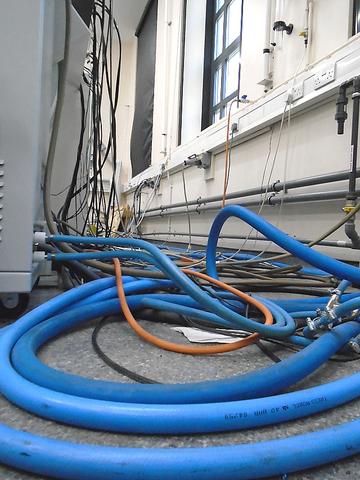NewUserChecklist
Training Resources
New Users of the CAESR SRF, operated by the Chemistry Department, should be aware of the resources available to learn more ESR. The first place to start is to read through CÆSR webpages wherein many details are mentioned that will help ensure successful
ESR research. Here is a list in approximate sequence that New Users should pursue (file links require a Chemistry network connection):
0. Read the CÆSR website pages.
1. Induction. On the homepage there is the Scientific Inductions Session Slides. This
is a 20 min. presentation given by the Scientific Applications Manager to new PDRAs, D.Phils., and Part IIs at the start of the academic year, typically in the first week of October in the ICL lecture theatre.
2. Forms. The CÆSR User Form on the door of the F12 lab of the X-/W-band spectrometer needs
to be read carefully by yourself, the user, and signed by you and your supervisor. There is a LASER document LS1, that describes the many LASERs in
CÆSR. If you plan to use LASERs in CÆSR, you must read this very carefully and sign the LS4 user form. Be prepared
for a Co-Director to quiz you on the LS1 details before the LS4 document is completed and submitted to the Chemistry Department LASER Safety Officer.
3. You need to meet with the Scientific Applications Manager, who is responsible for the day-to-day operation of CÆSR SRF. Please explain your research project clearly and make a research plan.
Be aware that some projects develop over weeks to months and expertise is available in many aspects of ESR, which may greatly expedite the conclusion of your research. It is very difficult for other people to know that you need help, if
you don't ask for help or a meeting participation.
4. New Users directory. Chemistry Department users may access a directory of learning resources with computers connected via a hard line to the Chemistry Network. a. Left-click
on the Start window, b. type Run in the query box Search Programs and Files, c. Select Run with arrows, d. in the open query box, enter \\chem.ox.ac.uk\SRF\ESR, e. a
new window will open, double-click on the NewUser_IntrosAndFAQ directory. There is a set of CÆSR logo images in this directory for talks and posters. If you are not a Chemistry Department member, please note that the EMXmicro, E580,
and E680 have a directory on their desktop called StartHere_NewUser, which is a duplicate of the NewUser_IntrosAndFAQ directory. Here are some of the contents, listed below:
\\chem.ox.ac.uk\SRF\ESR\NewUser_IntrosAndFAQ (or ../StartHere_NewUser/)
\CAESR_IntroLecture
\ESRpractical
\PostLabFiles
\Simulation_ModelAnswers
\HowTo_getFiles_FillTubes
FileTransfer_conversion.pdf -- how to use FTP to get data remotely
wkmTubeFilling.m -- how to fill
tubes (requires Matlab)
\Pedagogy_EPR_and_Matlab
\EPR_summer_school -- 2015 EF-EPR program 148 Mb, 17 excellent
lectures
\Matlab_HelpDocs
easyspin_exercises.pdf -- EasySpin exercises, taken from an EasySpin
workshop
matlab_diktaat.pdf -- Introduction
to Matlab for Chemists, matrix operations
tutorial.pdf
-- more Matlab: Matrices, Kinetics, ODEs, PDEs, Fourier, FEM
BrukerSlides_CW ...pdf -- Official slides for the Bruker BioSpin talk
on CW-EPR
BrukerSlides_Pulsed ...pdf -- Official slides for the Bruker BioSpin talk on Pulsed EPR
Eaton2010_QuantitativeEPR.pdf -- Highly recommended book by Eatons, Barr, and Weber
VideoLectureLinks.pdf -- ISMAR video lectures on EPR by Prof. Daniella Goldfarb
\Safety
\EPR LASER LAB F12
5. Key websites. a. www.easyspin.org has much documentation and examples explaining how to perform EPR simulations with its freely-available package of Matlab routines b. http://www.epr.ethz.ch/
is Prof. Gunnar Jeschke's group with tremendous Software and Education resources, among a plethora of exemplary EPR publications. c. https://orcaforum.cec.mpg.de/ Some of the most accurate calculations of
EPR Spin Hamiltonian parameter values are performed with the ORCA ab initio, DFT, and semi-empirical package. Easyspin works well with ORCA calculation outputs.
6. Graduate Training Week (Day). Groups of two or three may sign-up at the Scientific Induction Session for the training week,
where they have one day to get a tour of CÆSR, explanation of resources, a demonstration of CW- and Pulsed EPR, ENDOR, DEER, and LASER-induced transient EPR, followed by a hands-on period to use the spectrometer yourself to perform T1e, phase
memory, and ESEEM measurements. This one day training is available on request through-out the year, noting that booking requirements may create a delay of up to one month, contact the Scientific Applications Manager.
If you cannot attend the Scientific Induction Session, and wish to attend the October training week, please send an e-mail.
7. EPR Practical. The third year Inorganic EPR Practical is designed as a cumulative two-day exercise
of about twelve hours total. It is a largely qualitative exercise that introduces basic concepts of EPR research and applications rather than further improve strong skills in quantum mechanics. The first day involves EPR simulations
and the second day involves CW-EPR measurements at 100, 200, and 300K of CuTPP in toluene and neat copper acetate powder using a full cryogenic setup. In addition to ~20 third year students per year, Part IIs, D. Phils and even PDRAs benefit
from the exercise.
8. Bruker Manuals. In many EPR groups new members must fend for themselves. One way to learn how to use EPR spectrometers is to Read The Manual (RTM). A very large collection of Bruker manuals, workshops slides,
technical notes and more is available in \\chem.ox.ac.uk\SRF\ESR\BrukerManuals and on the spectrometer computers in desktop folders. Because help is available in CÆSR, you are encouraged to ask for help rather than pursue uncertain spectrometer
operations that are new to you, alone.
9. Graduate Lecture Course. (under development) This will be a hands-on transferable skills course of eight sessions, as requested by the Deputy Head of Teaching in summer 2017.
10. CÆSR Seminars. Throughout the year, CÆSR hosts and lists seminars that contain ESR-related research, see the Meetings tab above. You are strongly recommended to attend. In April there is
the RSC-ESR conference with registration and abstract deadlines in early February. If you have an ESR related talk to give, please inform the Scientific Application Manager to schedule a time.



